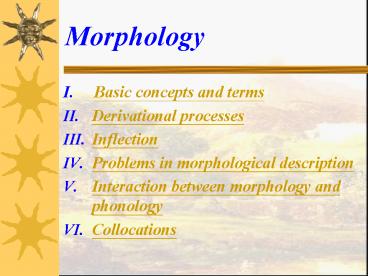Morphology - PowerPoint PPT Presentation
Title: Morphology
1
Morphology
- I. Basic concepts and terms
- Derivational processes
- Inflection
- Problems in morphological description
- Interaction between morphology and phonology
- Collocations
2
Basic Concepts and Terms
- Morphology the study of forms
- Morpheme the smallest meaningful units of
language - A. Free morpheme can occur by itself
- lexical morpheme Its possible to add new words
- functional morpheme New words are rarely added
- B. Bound morpheme must attach to free morpheme
- derivational morpheme capable of making new
words - inflectional morpheme indicates the grammatical
aspect - Stem (root, base) e.g. teach
- Affix
- Prefix e.g. unhappy
- Infix e.g. Absogoddamlutely
- Suffix e.g. happiness
3
Free Morpheme
- Definition can occur by itself, not attached to
other morphemes - Examples girl, teach, book, class, etc.
- Two kinds
- A. lexical morpheme (open class)
- 1. definition has lexical meaning new
examples can be freely added - 2. examples N, Verb, Adj, Adv (content
words) - B. functional morpheme (closed class)
- 1. definition new examples are rarely added
(but not impossible to add) - 2. examples Pro, Prep, Conj, Art. (function
words)
4
Bound Morpheme
- I. Derivational morpheme
- may change syntactic class
- to form new words
- examples -able, un-, re-, etc.
- II. Inflectional morpheme
- Different forms of the same word
- Not change syntactic class
- Only 8 kinds in English -s, -s (plural nouns),
-ing, -ed/-en, -est, -er, -s (S-V agreement)
5
II. Derivational Processes a method to get new
words
- Derivation (Derivational affixation)
- Compounding combine two or more morphemes to
form new words - Reduplication full or partial repetition of a
morpheme - Blending parts of the words that are combined
are deleted - Clipping part of a word has been clipped off
- Acronyms abbreviate a longer term by taking the
initial letters - Back formation A word (usually a noun) is
reduced to form another word of a different type
(usually a verb) - Extension of word formation rules Part of a word
is treated as a morpheme though its not - Functional shift (Conversion) A change in the
part of speech - Proper names ? Common words
- Onomatopoeia words imitate sounds in nature
- Borrowing The taking over of words from other
languages
6
III. Inflection Function words
- Definition adds some grammatical functions
related to - Syntax, but does not create new words.
- A list of Function words in English (see Nash 65)
- All the inflectional morphemes in English are
suffixes. - Basic word structure in English
- (DER) Base (DER) (INFL)
- e.g. .. Plant er s
- im Polite
7
IV. Problems in Morphological Description
- For example
- Noun ADJ
- Law (English) Legal (Old Norse)? due to
historical influence - Mouth (English) Oral (Latin)
- The above examples arent suitable for people
- to analyze by using morphological rules
- More examples
- Sheep Sheep (plural form)
- Read Read (past tense)
8
V. Interaction Between Morphology and Phonology
- A. Past tense in English
- 1. ends with V /d/
Ex agreed, dragged - 2. ends with -V /t/
Ex worked, missed - 3. ends with alveolar stop
/id/ Ex load, estimated - B. Plural form
- 1. ends with V /z/
Ex flags, games - 2. ends with -V /s/
Ex maps, banks - 3. ends with sibilant /iz/
Ex glasses, watches - Morphophonemic Rules The rules that
determine the pronunciation of the regular past
tense and plural morphemes are called
morphophonemic rules because morphology adds the
suffix to the root, and the phonology controls
the pronunciation of the morpheme. - C. Negative (Nash 51)
9
VI. Collocation
- Definition
- There are combinations of words which are
stored together as whole units in the brain,
sometimes like big words. A speaker calls up the
units as a whole form from memory, just as he
calls up individual words. - Examples
- Salt and Pepper
- Knife and Fork
- Bread and Butter
- Do business
- Do harm
- Make a mistake








![Read [PDF] Dental Anatomy and Morphology PowerPoint PPT Presentation](https://s3.amazonaws.com/images.powershow.com/10086902.th0.jpg?_=202407270711)






















